SILLABUS I confirm
Azerbaijan Medical University Head of Department
«Children's Diseases» subject of «Children's Diseases II»
WORKER TRAINING PROGRAM prof. N.S.Sultanova
Signature ____________
___.____________.2023
SILLABUS
(educational-methodical program for organization of student's free work)
Faculty: General medicine
Department: «Children'sdisease II»
Education term of subject: VIII
Academic year: 2022/2023
Course: IV
Instructors: Teaching staff of the department
Teaching load: practic lessons 65 hours + lecture 10 hoursTeaching method of subject: practic lessons (4 h)+ lecture (2h)
Subject code: İPF-B39
Subject type: Mandatory
Subject credits: 4
Instruction languages of subject:azerbaijan, russian, english.
Contacts: +994 51 599 06 24
E/mail: [email protected]
PREREQUISITE:
Subjects that must be taught in advance: «Anatomy», «Physiology», «Pathological Anatomy», «Pathological Physiology», «Biochemistry», «Pharmacology», «Propaedeutics of Pediatrics».
COREQUISITE:
There is no need to teach other subjects simultaneously with the teaching of this subject.
COURSE OBJECTIVES:
In the IV-V courses the main purpose of teaching children's illnesses is to acquire knowledge about the etiology, pathogenesis of frequently encountered diseases in children. Improving and strengthening the examination habits in pediatric patients is the goal of teaching the basic principles of clinical thinking, clinical diagnosis, obtaining differential diagnostic skills, and the treatment and prophylaxis of frequently encountered diseases.
At the 6th course, students are conducting a clinical training course in clinical departments and outpatient clinics as well as participate in multidisciplinary studies of the head of the department, professors and docents.
Clinical analysis of the lectures on the subject of the problem and the clinical analysis of practical subjects is accompanied by a detailed examination of the results of modern paraclinic examinations (instrumental, laboratory-biochemical, etc.).
COURSE RESULTS:
During IV-V courses, students acquire professional habit of examining patients, study diagnostics, differential diagnostic tactics, urgent emergency care, and medical documentation. In the VI course, syndrome and detailed differential diagnosis are studied. Upon completion of this course, students should be aware of the anatomo-physiological characteristics of different aged children and the measures they encounter. To achieve these, students will gain the most up-to-date medical equipment, the ability to accurately diagnose diagnosis and correct diagnosis by studying their primary diagnostic and prognostic markers, and correctly diagnosing the diagnosis.
THEMATIC PLAN OF LECTURES FOR STUDENTS OF THE FACULTY OF GENERAL MEDICINE ON THE SUBJECT
«CHILDREN'S DISEASES»
IV COURSE (VIII SEMESTER)
|
№ |
Topics |
Hours |
|
1. |
History of Pediatrics. The main directions of development of pediatrics. Organization of medical care for the children's population of the Azerbaijan Republic. Features of pediatric pathology. The importance of hereditary factors in the development of pediatric pathology. |
2 |
|
2. |
Problems of modern neonatology. Perinatal pathologies. Characteristics of full-term and premature newborns. Border (transient) states. Pathology of the neonatal period. Birth trauma. Diseases of the skin and navel. Sepsis. Intrauterine infections (toxoplasmosis, rubella, herpes, cytomegaly). |
2 |
|
3. |
Pneumonia in infant. The role of acute respiratory infections in the development of pneumonia. Features of the course of pneumonia in full-term and premature newborns depending on the anatomical and physiological characteristics of the respiratory tract, differential diagnosis. Treatment, prevention. |
2 |
|
4. |
Acute digestive disorders in children. Diarrhea. Etiology, pathogenesis, clinic. Intestinal toxicosis syndrome, treatment, prevention. Principles of rehydration therapy. |
2 |
|
5. |
Chronic malnutrition (dystrophies). Etiology, pathogenesis, classification, clinical picture, treatment, prevention. Rickets. Prevalence and role in pediatric pathology. Etiology, pathogenesis, clinical picture, treatment and prevention. |
2 |
|
Summury |
10 |
|
THEMATIC PLAN FOR PRACTICAL LESSONS IN THE SUBJECT
«CHILDREN'S DISEASES» FOR STUDENTS OF THE FACULTY OF GENERAL MEDICINE
IV COURSE (VIII SEMESTER)
|
№ |
Topics |
Hours |
|
1. |
Features of the neonatal period. Border (transient) states. Characteristics of full-term and premature newborns. Organization of care for newborns. Intrauterine growth retardation of newborns. |
4 |
|
2. |
Perinatal pathology of the central nervous system. Clinical picture, diagnosis and differential diagnosis, treatment (in the acute and recovery period). Prevention, prognosis. Principles of dispensary observation. |
4 |
|
3. |
Purulent-inflammatory diseases of newborns. Diseases of the skin and navel. |
4 |
|
4. |
Intrauterine infections. Toxoplasmosis, listeriosis, cytomegaly, rubella, herpes. Etiology, pathogenesis, clinical picture, diagnosis and treatment. |
4 |
|
5. |
Sepsis in newborns. Etiology, pathogenesis. Clinical forms, diagnostics. Treatment and principles of prevention. |
4 |
|
6. |
Neonatal jaundice, classification. Conjugative jaundice. |
4 |
|
7. |
Hemolytic jaundice. Hemolytic disease of the newborns. |
4 |
|
8. |
Features of the course of pneumonia in newborns. Diagnostics and treatment principles. |
2 |
|
9. |
Anemia of newborns. Classification, clinic, diagnosis and treatment. |
4 |
|
10. |
Acute respiratory infections. Etiology, clinic, diagnosis, treatment and prevention. Croup, emergency care. |
4 |
|
11. |
Features of the course of pneumonia in infant. Treatment and prevention. |
2 |
|
12. |
Anemia in young children. Deficiency anemia. Etiology, clinical picture, laboratory diagnostics. Differential diagnosis. Treatment and prevention. |
4 |
|
13. |
Diseases of the digestive system in young children. Semiotics of diseases of the oral cavity. Alimentary diarrhea. Intestinal toxicosis. Etiology, diagnosis, treatment principles. |
4 |
|
14. |
Chronic malnutrition (dystrophy). Hypotrophy of I, II, III degree, hypostatura, paratrophy, kwashiorkor, marasmus. Etiology, pathogenesis, prevention. |
4 |
|
15. |
Hypo- and avitaminosis. Hypervitaminosis. |
4 |
|
16. |
Rickets. Etiopathogenesis, clinical, biochemical, radiological changes. Diagnostics, treatment and prevention. Rickets-like diseases. |
4 |
|
17. |
Spasmophilia. Clinical forms and symptoms. Treatment. D hypervitaminosis. Treatment. |
2 |
|
18. |
Children who get sick often. Classification, etiology, clinic, treatment |
3 |
|
Summury |
65 |
|
FREE WORK:
During the semester each student is given the task 10 topics to work freely. Performance of each work assignment is 1 point.
The work should be in a written form, in the form of word file, size 4-5 pages (font-12).
Plagiarism is unacceptable because every free work is a collection of individual ideas.
TOPICS FOR FREE WORK FOR STUDENTS OF THE IV COURSE
FACULTY OF GENERAL MEDICINE ON THE SUBJECT OF «CHILDREN'S DISEASES»
|
№ |
Topics |
|
1 |
Features of newborn. |
|
2 |
Causes and classification of prematurity. |
|
3 |
Assessment of the health of a newborn. |
|
4 |
Transient conditions of newborn. |
|
5 |
Preterm and term newborn care. |
|
6 |
Perinatal pathology of the CNS. Etiology, clinical manifestation. |
|
7 |
Perinatal pathology of the CNS. Diagnosis and differential diagnosis. |
|
8 |
Treatment of perinatal pathology of the CNS (in the acute and recovery period). Prevention. Forecast. Principles of dispensary observation. |
|
9 |
Intrauterine infections of newborns: toxoplasmosis, herpes, cytomegaloviral infection. |
|
10 |
Congenital skin diseases of non-infectious etiology. |
|
11 |
Infectious skin diseasesin newborn. Disease of navel. Etiology, pathogenesis, clinical features. |
|
12 |
Sepsis, etiology, pathogenesis, clinical forms, diagnostics. Principles of treatment. Prevention |
|
13 |
Neonatal jaundice. Classification. Pathogenesis. |
|
14 |
Clinical and laboratory characteristics of jaundice. |
|
15 |
Algorithm for the examination of newborns with jaundice. |
|
16 |
Etiology and pathogenesis of hemolytic disease of the newborn. Treatment principles, prevention. |
|
17 |
Anemia of newborns, causes, clinic, diagnosis. |
|
18 |
Anemia in infant, diagnosis, differential diagnosis. Anemia treatment and prevention. |
|
19 |
Anatomical and physiological features of the respiratory system in infant. |
|
20 |
The development of pneumonia in newborns, features of the course, diagnosis. Treatment and prevention. |
|
21 |
Clinical features of pneumonia in infant. Diagnostics, treatment, prevention. |
|
22 |
Acute respiratory viral infections in children. Etiology, clinic, treatment, prevention. |
|
23 |
Croup syndrome in children. Etiology, clinic, treatment. Urgent care. |
|
24 |
Diseases of the oral cavity in infant. |
|
25 |
Alimentary diarrhea. Etiology, diagnosis. Treatment, prevention. |
|
26 |
Intestinal toxicosis. Etiology, diagnosis. Treatment principles, prevention. Rehydration principles. |
|
27 |
Chronic digestive disorders. Etiology, classification, clinical manifestation, diagnostics. Principles of treatment and prevention. |
|
28 |
The principles of feeding in the treatment of malnutrition. |
|
29 |
Rickets. Etiology, pathogenesis. Classification of rickets. Clinical course, diagnostics. Treatment and prevention of rickets. |
|
30 |
Rickets-like diseases. Differential diagnosis of rickets and rickets-like diseases. |
|
31 |
Hypervitaminosis D. Clinical manifestation. Treatment and prevention. |
|
32 |
Spasmophilia. Pathogenesis, clinical forms, treatment and prevention. |
LIST OF PRACTICAL SKILLS FOR IV YEAR STUDENTS OF THE FACULTY OF GENERAL MEDICINE IN THE SUBJECT OF «CHILDREN'S DISEASES »
|
№ |
Topics |
|
1 |
Determination of the severity of asphyxia in newborns according to the Apgar scale. |
|
2 |
Determination of the degree of maturity of the newborn according to the Ballard scale. |
|
3 |
Determination of the severity of respiratory distress syndrome in newborns according to the Silverman scale. |
|
4 |
Anthropometric indicators in children. |
|
5 |
Signs of morphological immaturity in premature. |
|
6 |
Determination of congenital unconditioned reflexes in newborns. |
|
7 |
Assessment of the psychophysical development of children at different age periods. |
|
8 |
Rules for palpation and percussion of liver in children. |
|
9 |
Rules for auscultation of the lungs in children. |
|
10 |
Determination of the degree of malnutrition based on the Chulitskaya index and clinical signs. |
|
11 |
The procedure for feeding a newborn baby with a tube. |
|
12 |
Rules for rehydration therapy. |
|
13 |
The procedure for the administration of drugs to children through a nebulizer. Methods of oxygen therapy for a newborn (with a mask, nasopharyngeal probe). |
|
14 |
Interpretation of the results of a complete blood count. |
|
15 |
Providing emergency care for hypocalcemic seizures. |
|
16 |
Determination of the degree of rickets in children based on clinical and laboratory studies. |
ESTIMATION
100 points, necessary in subject, will be divided as follows:
Also:
10 points - visit of occupations
10 points - free work
During a semester (12 days) to be carried out 3 colloquiums. If the student doesn't participate in a colloquium, then 0 points are written in the magazine Examination is held on the basis of tests. Each question - 1 point.
NOTE:
The points gained prior to examination and at examination are summarized and the total point is estimated according to the following scheme:
A – «excelent » - 91-100
B – «very good» - 81-90
C – «good» - 71-80
D – «satisfactory» - 61-70
E - «passable» - 51-60
F- «unsatisfactory» - less 51
SILLABUS- THE WORKING TRAINING PROGRAM
The contents of the program of the bachelor cover planning of educational process, a form and methods of its application, volume of educational loading, duration of grade levels (semester), types of training (a lecture, practice, laboratory, etc.), volume of separate objects, requirements imposed to educational programs for specialties.
Planning and the organization of processes of training is carried out on the basis of working programs for objects and curricula (the approximate worker and the individual). The form and structure of these documents is defined by a higher educational institution.
Subject programs for specialties are prepared by higher educational institutions, according to requirements of higher educational programs and are confirmed by the Ministry of Education of the Azerbaijan Republic. On the basis of subject programs working programs (syllabuses) are developed and is confirmed from higher educational institutions
The working training program - prepares on the basis of a subject and represents the document displaying the description of a subject, the purpose, the summary, duration of occupations, hours of consultations, information on the teacher, requirements of the teacher, evaluation criteria, the intermediate table of estimation, the list of the used literature.
REFERENCE
- A.A. Əyyubova, H.H.Qabulov, N.H.Sultanova. Uşaq xəstəlikləri /Dərslik/ Bakı 2018, 558 səh.
- N.Ə.Tağıyev. Neonatologiya /Dərslik/, Bakı 2008, 535 səh.
- S.Ş.Həsənov. Yenidoğulan uşaqların reanimasiyası və intensiv terapiyası /Dərs vəsaiti/. Bakı 2009, 212 s.
- S.M.Qasımova, N.C.Quliyev, Ü.Ə.Əliyeva, Uşaq xəstəlikləri, /Dərslik/, Bakı 2016, 660 səhifə.
- Pediatriya. İ.İ. İsayev, S.Q. Xanməmmədova, R.R Məmmədova, N.Q. Hüseynov. Bakı 2017,482səh.
- Uşaq xəstəliklərinin propedevtikası. İ.İ. İsayev. Bakı 2011, 571 səh.
- S.Z.Qarayeva. Uşaq xəstəlikləri /Dərs vəsaiti/ Bakı, 2014, 186 səh.
- N.A. Hüseynova, N.C.Quliyev və b. Uşaq qastroenterologiyası /Dərs vəsaiti/ 2013, 391 səh.
- N.A. Hüseynova, N.C. Quliyev və b. Pediatriyada pəhriz terapiyası /Dərs vəsaiti/ 2014, 276 səh.
- А.А. Баранов.Детскиеболезни /Учебник/2-е изд, испр. и доп.-М.: ГЭОТАР-Медиа, 2012.-1008 с.
- Н.П. Шабалов.Детскиеболезнив 2-хтомах /Учебник/, 6-е изд. перераб. и доп. –СПб.:Питер 2012 (Учебник для вузов).
- Н.П. Шабалов. Неонaтология. В 2-т. Учеб.пособие, 5-е изд. испр. и доп. –М.: МЕДпресс-информ, 2009.
- P. Veliyev.Pediatrik Diseases /The Textbook/ Baku, 2012, 259 page.
- Детские болезни. Н.П.Шабалов в 2-х томах. Санкт-Петербург, 2006.
TECHNICAL SUPPLIES
Puloxymeter, spirometer, neurosonograph, nebulaser


 English
English Русский
Русский




